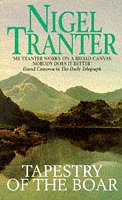The latest in my Nigel Tranter novel re-read is Tapestry of the Boar. This is set in roughly the same period as my last read, Lord of the Isles (12thC), but on the mainland, close to Nigel Tranter's own stomping grounds in the Lothians.
Our hero, based on a real-life character, is Sir Hugh de Swinton. He is the second son of a modest laird who makes a name for himself by killing wild boars. These were dangerous creatures who could terrorise sheep, the primary source of income in the eastern borders, and the local population.
He came to the attention of King Malcolm and took part in punitive expeditions into Galloway to put down rebellions. He and his friends, including an early member of the Bruce family, acted mainly as scouts. He was rewarded with a small landholding on the coast. Unfortunately, King Malcolm was not one of Scotland's finest, considerably under the sway of King Henry of England, and he died pretty young. He also chose Hugh to escort the bride of a royal marriage to the Netherlands. So, we get the flavour of overseas travel.
He went north to the Mearns to assist a local Thane in another rebellion linked to Somerled's action. There he meets the Thane's daughter, and a long-distance romance begins. I won't go into the detail, but the line established exists to this day.
It's a decent story, but not quite the page-turner of the classic Tranter stories. No-fault of the bold Sir Hugh who lived in a relatively stable period, but perhaps not the most gripping read.
The troop type he led would be the early border mosstroopers. The light cavalry of the period. They are better known as the Border Reivers of later centuries but were pretty similar during this period.
 |
| Some later Border Reivers, acting in a Game of Thrones battle. |

No comments:
Post a Comment